Jean-François Lalonde
GaSLight: Gaussian Splats for Spatially-Varying Lighting in HDR
Apr 15, 2025Abstract:We present GaSLight, a method that generates spatially-varying lighting from regular images. Our method proposes using HDR Gaussian Splats as light source representation, marking the first time regular images can serve as light sources in a 3D renderer. Our two-stage process first enhances the dynamic range of images plausibly and accurately by leveraging the priors embedded in diffusion models. Next, we employ Gaussian Splats to model 3D lighting, achieving spatially variant lighting. Our approach yields state-of-the-art results on HDR estimations and their applications in illuminating virtual objects and scenes. To facilitate the benchmarking of images as light sources, we introduce a novel dataset of calibrated and unsaturated HDR to evaluate images as light sources. We assess our method using a combination of this novel dataset and an existing dataset from the literature. The code to reproduce our method will be available upon acceptance.
SpotLight: Shadow-Guided Object Relighting via Diffusion
Nov 27, 2024Abstract:Recent work has shown that diffusion models can be used as powerful neural rendering engines that can be leveraged for inserting virtual objects into images. Unlike typical physics-based renderers, however, neural rendering engines are limited by the lack of manual control over the lighting setup, which is often essential for improving or personalizing the desired image outcome. In this paper, we show that precise lighting control can be achieved for object relighting simply by specifying the desired shadows of the object. Rather surprisingly, we show that injecting only the shadow of the object into a pre-trained diffusion-based neural renderer enables it to accurately shade the object according to the desired light position, while properly harmonizing the object (and its shadow) within the target background image. Our method, SpotLight, leverages existing neural rendering approaches and achieves controllable relighting results with no additional training. Specifically, we demonstrate its use with two neural renderers from the recent literature. We show that SpotLight achieves superior object compositing results, both quantitatively and perceptually, as confirmed by a user study, outperforming existing diffusion-based models specifically designed for relighting.
Material Transforms from Disentangled NeRF Representations
Nov 12, 2024



Abstract:In this paper, we first propose a novel method for transferring material transformations across different scenes. Building on disentangled Neural Radiance Field (NeRF) representations, our approach learns to map Bidirectional Reflectance Distribution Functions (BRDF) from pairs of scenes observed in varying conditions, such as dry and wet. The learned transformations can then be applied to unseen scenes with similar materials, therefore effectively rendering the transformation learned with an arbitrary level of intensity. Extensive experiments on synthetic scenes and real-world objects validate the effectiveness of our approach, showing that it can learn various transformations such as wetness, painting, coating, etc. Our results highlight not only the versatility of our method but also its potential for practical applications in computer graphics. We publish our method implementation, along with our synthetic/real datasets on https://github.com/astra-vision/BRDFTransform
ZeroComp: Zero-shot Object Compositing from Image Intrinsics via Diffusion
Oct 10, 2024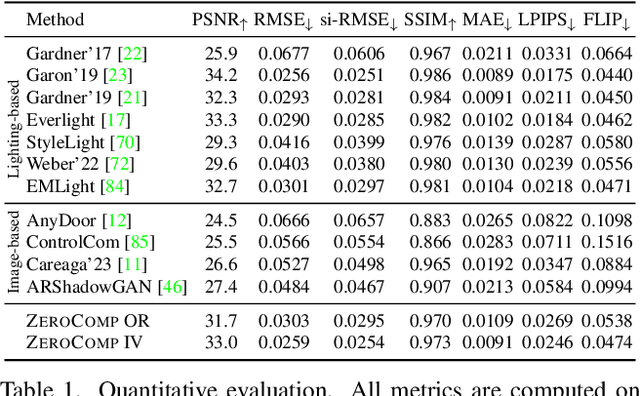
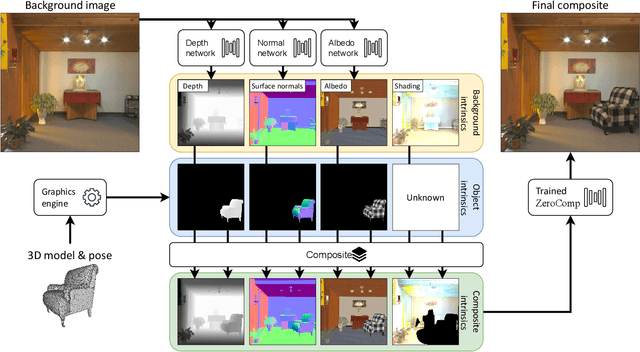
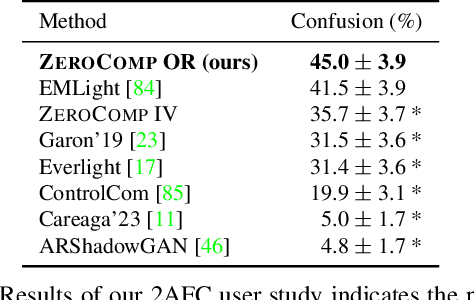
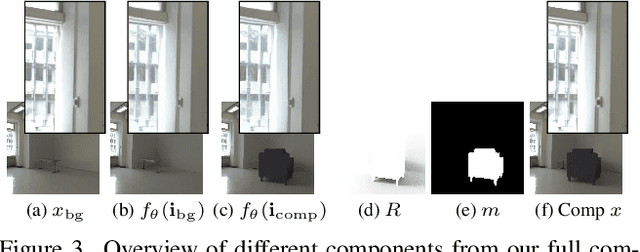
Abstract:We present ZeroComp, an effective zero-shot 3D object compositing approach that does not require paired composite-scene images during training. Our method leverages ControlNet to condition from intrinsic images and combines it with a Stable Diffusion model to utilize its scene priors, together operating as an effective rendering engine. During training, ZeroComp uses intrinsic images based on geometry, albedo, and masked shading, all without the need for paired images of scenes with and without composite objects. Once trained, it seamlessly integrates virtual 3D objects into scenes, adjusting shading to create realistic composites. We developed a high-quality evaluation dataset and demonstrate that ZeroComp outperforms methods using explicit lighting estimations and generative techniques in quantitative and human perception benchmarks. Additionally, ZeroComp extends to real and outdoor image compositing, even when trained solely on synthetic indoor data, showcasing its effectiveness in image compositing.
DarSwin-Unet: Distortion Aware Encoder-Decoder Architecture
Jul 24, 2024



Abstract:Wide-angle fisheye images are becoming increasingly common for perception tasks in applications such as robotics, security, and mobility (e.g. drones, avionics). However, current models often either ignore the distortions in wide-angle images or are not suitable to perform pixel-level tasks. In this paper, we present an encoder-decoder model based on a radial transformer architecture that adapts to distortions in wide-angle lenses by leveraging the physical characteristics defined by the radial distortion profile. In contrast to the original model, which only performs classification tasks, we introduce a U-Net architecture, DarSwin-Unet, designed for pixel level tasks. Furthermore, we propose a novel strategy that minimizes sparsity when sampling the image for creating its input tokens. Our approach enhances the model capability to handle pixel-level tasks in wide-angle fisheye images, making it more effective for real-world applications. Compared to other baselines, DarSwin-Unet achieves the best results across different datasets, with significant gains when trained on bounded levels of distortions (very low, low, medium, and high) and tested on all, including out-of-distribution distortions. We demonstrate its performance on depth estimation and show through extensive experiments that DarSwin-Unet can perform zero-shot adaptation to unseen distortions of different wide-angle lenses.
PanDORA: Casual HDR Radiance Acquisition for Indoor Scenes
Jul 08, 2024

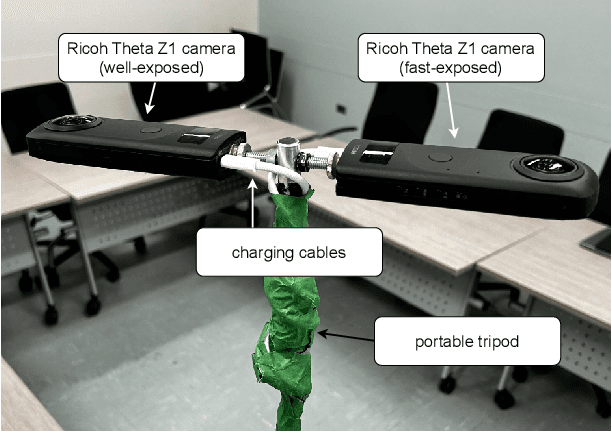
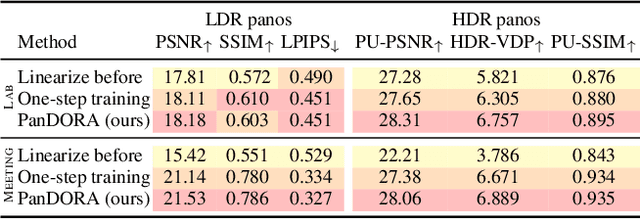
Abstract:Most novel view synthesis methods such as NeRF are unable to capture the true high dynamic range (HDR) radiance of scenes since they are typically trained on photos captured with standard low dynamic range (LDR) cameras. While the traditional exposure bracketing approach which captures several images at different exposures has recently been adapted to the multi-view case, we find such methods to fall short of capturing the full dynamic range of indoor scenes, which includes very bright light sources. In this paper, we present PanDORA: a PANoramic Dual-Observer Radiance Acquisition system for the casual capture of indoor scenes in high dynamic range. Our proposed system comprises two 360{\deg} cameras rigidly attached to a portable tripod. The cameras simultaneously acquire two 360{\deg} videos: one at a regular exposure and the other at a very fast exposure, allowing a user to simply wave the apparatus casually around the scene in a matter of minutes. The resulting images are fed to a NeRF-based algorithm that reconstructs the scene's full high dynamic range. Compared to HDR baselines from previous work, our approach reconstructs the full HDR radiance of indoor scenes without sacrificing the visual quality while retaining the ease of capture from recent NeRF-like approaches.
Reproducibility Study on Adversarial Attacks Against Robust Transformer Trackers
Jun 03, 2024Abstract:New transformer networks have been integrated into object tracking pipelines and have demonstrated strong performance on the latest benchmarks. This paper focuses on understanding how transformer trackers behave under adversarial attacks and how different attacks perform on tracking datasets as their parameters change. We conducted a series of experiments to evaluate the effectiveness of existing adversarial attacks on object trackers with transformer and non-transformer backbones. We experimented on 7 different trackers, including 3 that are transformer-based, and 4 which leverage other architectures. These trackers are tested against 4 recent attack methods to assess their performance and robustness on VOT2022ST, UAV123 and GOT10k datasets. Our empirical study focuses on evaluating adversarial robustness of object trackers based on bounding box versus binary mask predictions, and attack methods at different levels of perturbations. Interestingly, our study found that altering the perturbation level may not significantly affect the overall object tracking results after the attack. Similarly, the sparsity and imperceptibility of the attack perturbations may remain stable against perturbation level shifts. By applying a specific attack on all transformer trackers, we show that new transformer trackers having a stronger cross-attention modeling achieve a greater adversarial robustness on tracking datasets, such as VOT2022ST and GOT10k. Our results also indicate the necessity for new attack methods to effectively tackle the latest types of transformer trackers. The codes necessary to reproduce this study are available at https://github.com/fatemehN/ReproducibilityStudy.
Towards a Perceptual Evaluation Framework for Lighting Estimation
Dec 13, 2023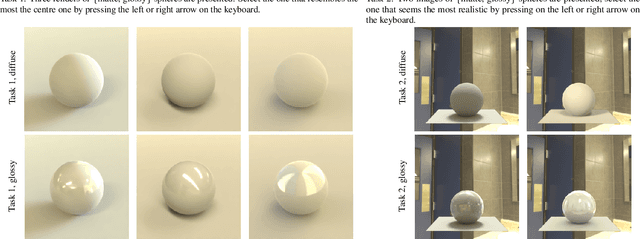
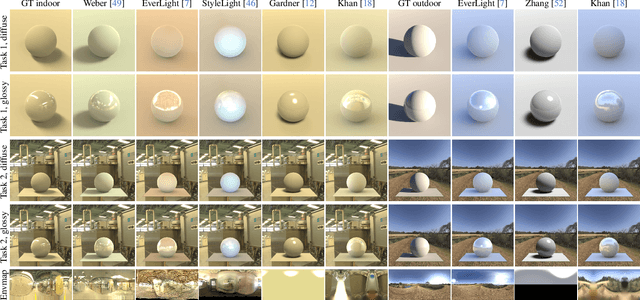
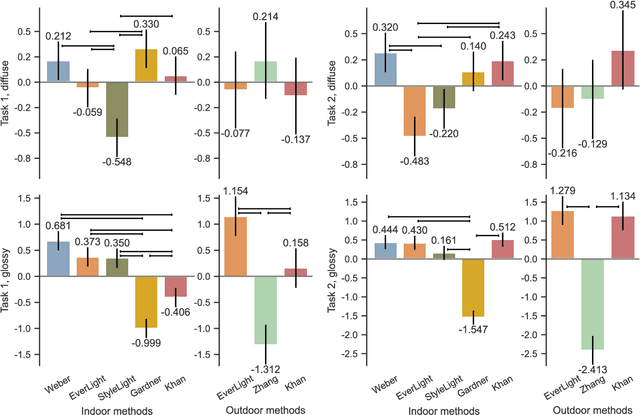
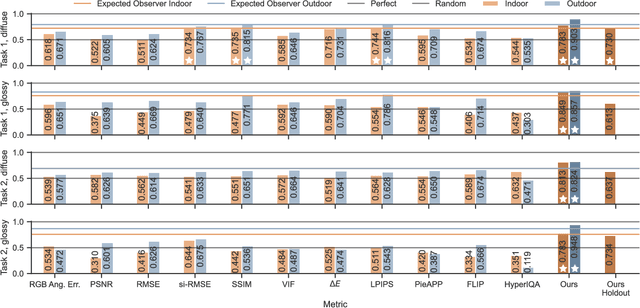
Abstract:Progress in lighting estimation is tracked by computing existing image quality assessment (IQA) metrics on images from standard datasets. While this may appear to be a reasonable approach, we demonstrate that doing so does not correlate to human preference when the estimated lighting is used to relight a virtual scene into a real photograph. To study this, we design a controlled psychophysical experiment where human observers must choose their preference amongst rendered scenes lit using a set of lighting estimation algorithms selected from the recent literature, and use it to analyse how these algorithms perform according to human perception. Then, we demonstrate that none of the most popular IQA metrics from the literature, taken individually, correctly represent human perception. Finally, we show that by learning a combination of existing IQA metrics, we can more accurately represent human preference. This provides a new perceptual framework to help evaluate future lighting estimation algorithms.
Domain Agnostic Image-to-image Translation using Low-Resolution Conditioning
May 11, 2023Abstract:Generally, image-to-image translation (i2i) methods aim at learning mappings across domains with the assumption that the images used for translation share content (e.g., pose) but have their own domain-specific information (a.k.a. style). Conditioned on a target image, such methods extract the target style and combine it with the source image content, keeping coherence between the domains. In our proposal, we depart from this traditional view and instead consider the scenario where the target domain is represented by a very low-resolution (LR) image, proposing a domain-agnostic i2i method for fine-grained problems, where the domains are related. More specifically, our domain-agnostic approach aims at generating an image that combines visual features from the source image with low-frequency information (e.g. pose, color) of the LR target image. To do so, we present a novel approach that relies on training the generative model to produce images that both share distinctive information of the associated source image and correctly match the LR target image when downscaled. We validate our method on the CelebA-HQ and AFHQ datasets by demonstrating improvements in terms of visual quality. Qualitative and quantitative results show that when dealing with intra-domain image translation, our method generates realistic samples compared to state-of-the-art methods such as StarGAN v2. Ablation studies also reveal that our method is robust to changes in color, it can be applied to out-of-distribution images, and it allows for manual control over the final results.
EverLight: Indoor-Outdoor Editable HDR Lighting Estimation
Apr 26, 2023


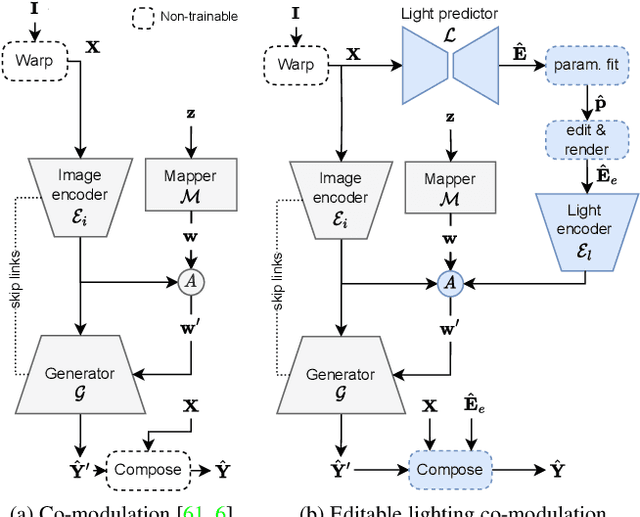
Abstract:Because of the diversity in lighting environments, existing illumination estimation techniques have been designed explicitly on indoor or outdoor environments. Methods have focused specifically on capturing accurate energy (e.g., through parametric lighting models), which emphasizes shading and strong cast shadows; or producing plausible texture (e.g., with GANs), which prioritizes plausible reflections. Approaches which provide editable lighting capabilities have been proposed, but these tend to be with simplified lighting models, offering limited realism. In this work, we propose to bridge the gap between these recent trends in the literature, and propose a method which combines a parametric light model with 360{\deg} panoramas, ready to use as HDRI in rendering engines. We leverage recent advances in GAN-based LDR panorama extrapolation from a regular image, which we extend to HDR using parametric spherical gaussians. To achieve this, we introduce a novel lighting co-modulation method that injects lighting-related features throughout the generator, tightly coupling the original or edited scene illumination within the panorama generation process. In our representation, users can easily edit light direction, intensity, number, etc. to impact shading while providing rich, complex reflections while seamlessly blending with the edits. Furthermore, our method encompasses indoor and outdoor environments, demonstrating state-of-the-art results even when compared to domain-specific methods.
 Add to Chrome
Add to Chrome Add to Firefox
Add to Firefox Add to Edge
Add to Edge